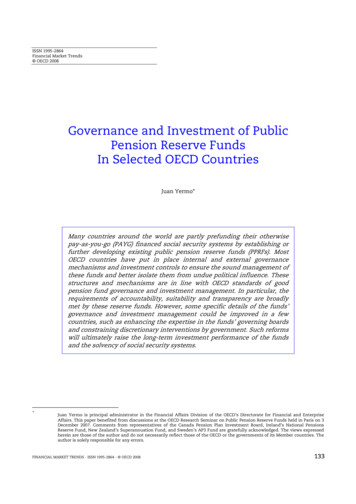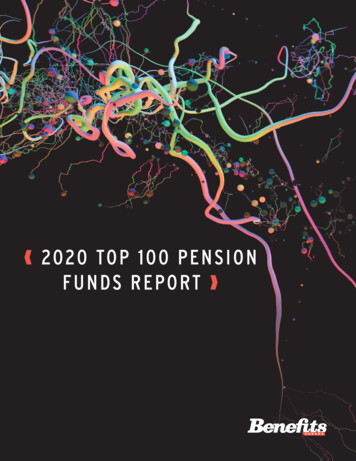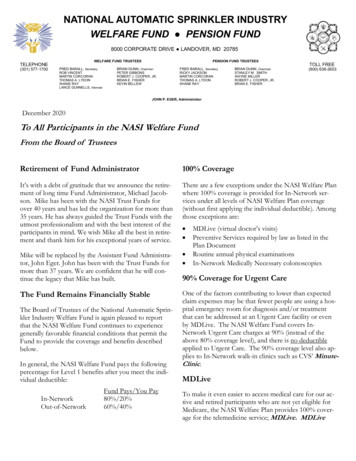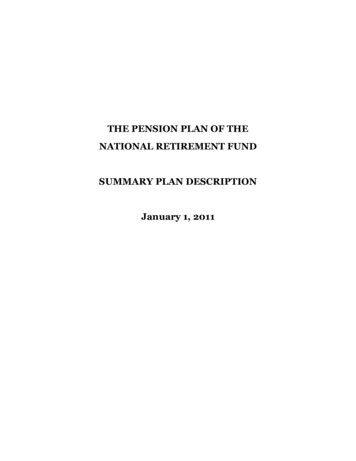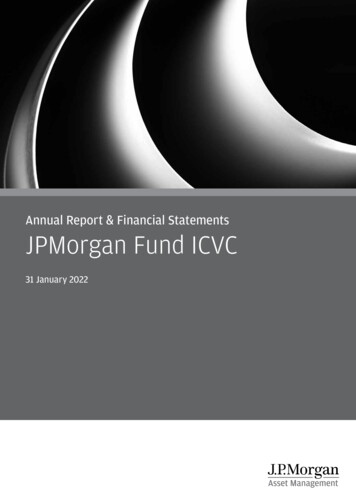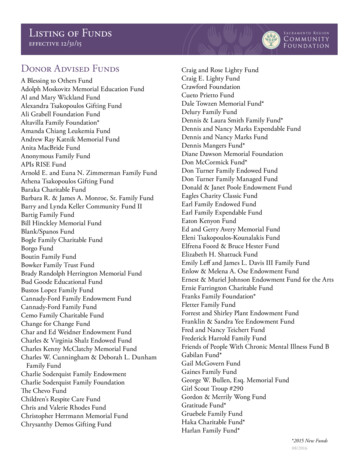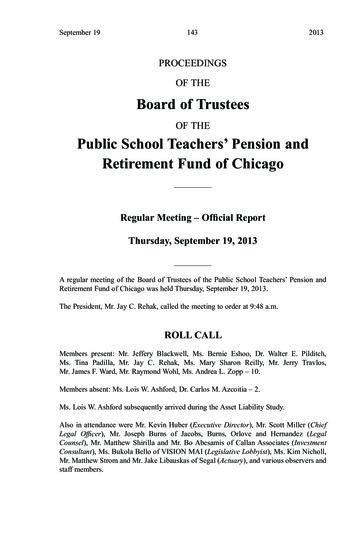
Transcription
CERN/FC/6574CERN/3643Original: English17 June 2022PENSION FUNDAnnual Reportand Financial Statements forthe year ended 31 DecemberAudited by representatives of theNATIONAL AUDIT OFFICE OF FINLAND2021
Action to be takenVoting ProcedureFor recommendationFINANCE COMMITTEE381st Meeting14-15 June 2022Simple majority of MemberStates represented and votingand 51% of the contributions ofall Member StatesFor decisionOPEN COUNCIL208th Session16-17 June 2022Simple majority of MemberStates represented and votingThe Finance Committee is invited to recommend to the Council and the Councilis invited to approve the Annual Report and Financial Statements of the CERNPension Fund for the year ended 31 December 2021 and to grant discharge tothe Chief Executive Officer.
PENSION FUNDAnnual Reportand Financial Statementsfor the year ended 31 December 2021The Financial Statements included in this Report are published in accordance withInternational Public Sector Accounting Standards (IPSAS) and the Rules andRegulations of the Pension Fund.
Table of contentsCHAIR’S REPORT . 4ANNUAL REPORTI. PENSION FUND GOVERNING BOARD REPORT . 81.Composition of the bodies of the Fund and Advisers (2021) . 82.Overview of the year 2021 . 123.Management Commentary . 164.Members and beneficiaries . 165.Actuarial Status of the Fund . 216.Investment Report . 26II. ANNEX . 32FINANCIAL STATEMENTSIII. AUDIT OPINION . 36IV. FINANCIAL STATEMENTS . 401.Statement of Financial Position . 402.Statement of Financial Performance. 413.Cash Flow Statement . 424.Statement of Changes in Net Assets Available for Benefits . 43V. NOTES TO THE FINANCIAL STATEMENTS . 44VI. EXTRACT OF ACTUARY’S REPORT ON THE FUND AS AT 31 DECEMBER 2021 . 782 84
3 84
Chair’s ReportAs Chair of the Pension Fund Governing Board (PFGB), it is mypleasure to present to you the Fund’s Annual Report andFinancial Statements for the financial year ending 31 December2021. I trust that this report will give you a useful update on thefinancial status of the Fund, as well as a summary of the activitiesin relation to members and beneficiaries and the investmentperformance over the last year.The purpose of the Fund is to insure its members andbeneficiaries as well as the members of their families against theeconomic consequences of disability, old age and death. Ouroperation is a global one and during the year we made paymentsof more than 320 MCHF to 3’763 beneficiaries residing in 48different countries and being of 39 different nationalities.This was despite the continued challenges of the COVID-19 pandemic which continued to affect all ofour daily lives in 2021 and I am grateful to the Fund’s Benefits Service who supported our members,beneficiaries and their families through these difficult times. The flexibility and openness from membersand beneficiaries to adopting different communication channels has been very much appreciated and itwas a pleasure to see such a high attendance at the annual information meeting in October, albeit viavideoconference.The economic environment and financial markets remained challenging over the year, however, theFund recorded another excellent return on investments, ahead of the Fund’s required rate of return andall relevant benchmarks. During the year the Fund achieved net gains and income of 310 MCHF. Aftertotal benefits and payments of 320 MCHF and receipt of member and employer contributions, net assetsincreased by 239 MCHF to 4.98 billon CHF.While the indications are that the world is finding ways to manage the human and economic disruptionfrom COVID-19, the developing situation in Ukraine prevents us from returning to a position of ease.The Fund, as does CERN, condemns, in the strongest terms, the military invasion of Ukraine by theRussian Federation, and deplores the resulting loss of life and humanitarian impact, as well as theinvolvement of Belarus in this unlawful use of force against Ukraine. As a Pension Fund our role is notto equate human suffering with financial matters, but we have a duty to consider the impact of theinvasion on our financial health. While we continue to hope that there is an imminent and orderlyresolution, we are closely monitoring the financial markets and taking action to ensure our beneficiariesare safe and continue to receive their benefits. A note has been included on page 77 in respect of thepost balance sheet event and the relatively immaterial value of assets held by the Fund directly affected.More generally, the financial markets had not returned to a sense of equilibrium and normal functioningafter the unprecedented fiscal responses to mitigate the impact of COVID-19. This affects how we valuethe assets held by the Fund but also influences our expectation of future returns. Complementing theaccounting valuation of the Fund under IAS 26 that takes place each year, every three years the Fundalso completes an actuarial review as a component of how we monitor our funding arrangements. Futureexpected returns form the basis of how we measure the obligations of the Fund to pay benefits in thefuture and the funding level is highly sensitive to the assumptions we make about the future. The nextactuarial review takes place in 2022 and the results will be communicated to Council in June and tomembers and beneficiaries later this year.4 84
This year, 2022 is “CERN’s Year of Environmental Awareness” and the Fund demonstrated its strongcommitment to managing climate-related risks and opportunities, as well as adopting a responsibleinvestment approach, by approving its first Environmental, Social and Governance (ESG) Policy at theend of 2021. More details of the new ESG policy, the performance of the different asset classes andother investment activities are included in the Investment Report in section 6 of this document.The CERN Council approved a small number of amendments to the Rules which included theintroduction of provisions relating to fraud prevention (Articles I 1.07, I 4.09 and I 4.10), and certaintechnical changes, mostly on matters related to benefits (Chapter II). Changes were also introduced inrespect of the procurement of a surviving spouse’s pension for beneficiaries of a retirement or totaldisability pension who married on or after 1 August 2006, including, in particular, modifications to ArticleII 5.09 and the introduction of a new Regulation (Chapter V).During the year the Fund welcomed a new CEO, Doug Heron, who brings a wealth of experience, havingpreviously been the CEO of the Lothian Pension Fund in Edinburgh, as well as holding a number ofdifferent executive roles in the finance sector in the United Kingdom and China.I would like to take this opportunity to extend my sincere thanks to Matthew Eyton-Jones for his valuablecontribution to the CERN Pension Fund during the six years as CEO of the Fund.The composition of the PFGB remained relatively stable during the year. Philippe Charpentier, themember appointed by the CERN and ESO Pensioners Association, joined the PFGB in April. TheInvestment Committee (IC) welcomed Georges Hübner as an external professional expert and theActuarial and Technical Committee (ATC) saw Marcus Klug appointed as Chair and Peter Hristov,Joanne Segars and Jan Robinson join as members. I would like to thank Jayne Atkinson for hersignificant contribution during her six years on the Investment Committee and extend my gratitude toAdrian Cunningham and Michel Baboulaz for their service to the ATC.In closing, I would like to thank all the members of the PFGB and its subcommittees for their continuedcommitment and dedication over the last year. On behalf of the PFGB members, I would also like towarmly thank our colleagues in the Pension Fund Management Unit for their excellent service to themembers and beneficiaries of the Fund.Ossi MalmbergChair, Pension Fund Governing Board5 84
ANNUAL REPORT6 84
7 84
I. Pension Fund Governing Board ReportThe PFGB is pleased to present its Annual Report and Financial Statements for the year ended31 December 2021.The purpose of the Fund is to insure its members and beneficiaries as well as the membersof their families against the economic consequences of disability, old age and death.(Article I 1.01).Composition of the bodies of the Fund and Advisers (2021)Governing BoardOssi MalmbergPeter HristovRaphaël BelloIsabelle MardirossianAndreas Hilka8 84Dirk RyckboschAndreas GlindemannJoanne SegarsMarcus KlugPhilippe Charpentier
MembersAppointed by:Ossi Malmberg, ChairCERN CouncilDirk RyckboschMarcus KlugESO CouncilRaphaël BelloEx-officio (in capacity as member ofCERN Management responsible forAdministration)Peter Hristov, Vice-ChairCERN Staff AssociationIsabelle MardirossianAndreas GlindemannESO Staff AssociationPhilippe Charpentier (as of 01.04.2021)CERN and ESO Pensioners AssociationAndreas HilkaProfessional members appointed byCERN CouncilJoanne SegarsInvestment CommitteeMembersRaphaël Bello, ChairJayne Atkinson (until 12.05.2021)Jacob BjorheimGeorges Hübner (as of 13.05.2021)Marcus KlugIsabelle Mardirossian9 84
Actuarial and Technical CommitteeMembersMarcus Klug, (Chair as of 19.02.2021)Adrian Cunningham, Chair (until 18.02.2021)Michel Baboulaz (until 18.02.2021)Peter Hristov (as of 18.02.2021)Jan Robinson (as of 15.04.2021)Joanne Segars (as of 18.02.2021)Chief Executive OfficerDoug Heron (as of 01.08.2021)Elena Manola-Bonthond (CEO ad interim from 01.07.2021 until 31.07.2021)Matthew Eyton-Jones (until 30.06.2021)Chief Investment OfficerElena Manola-BonthondChief Operating OfficerKandy Mitchell10 84
AuditorsAppointed by:CERN External AuditorsCERN CouncilNational Audit Office of Finland (NAOF), Helsinki, FinlandInternal AuditCERN CouncilCERN Internal Audit ServiceAdvisersFund ActuaryBuck Consultants Limited, London, UKCustodianNorthern Trust Global Services SE., LuxembourgMain BankerUBS SA, Nyon, SwitzerlandRisk ConsultantORTEC Finance AG, Pfäffikon, SwitzerlandCERN Consulting Medical PractitionerMEDABE SA, Monthey, Switzerland (as of 01.01 2021)11 84
Overview of the year 2021Pension Fund Governing BoardThe PFGB met six times during the year (2020: six times). Due to the continuing COVID-19 situation, allmeetings of the PFGB and its committees were conducted remotely, via videoconference.The PFGB’s agendas included recurrent items such as the approval of the submission of the Fund’sAnnual Report and Financial Statements to the CERN Council and the approval of the Fund’s risk limitand strategic asset allocation. In addition, the Fund’s Actuary presented the Fund’s actuarial “dashboard”to the PFGB, and the Pension Fund Management Unit (PFMU) presented the Fund’s annual budget foradministrative expenses and its medium-term plan for approval, as well as an update on the Fund’sInternal Control System and key business risks. The PFGB also reviewed the 2021-2024 programme ofwork for the internal audit of the Fund, as well as receiving two internal audit reports on real estateportfolio management and actuarial oversight. As part of the follow-up on these audits, the PFMUpresented updates on the implementation of the outstanding audit recommendations.2022 Periodic Actuarial ReviewA key part of the PFGB’s programme of work was the preparation for the periodic actuarial review.During the year, the PFGB approved the actuarial assumptions proposed by the Actuary for the periodicactuarial review as at 1 January 2022. The assumptions adopted were proposed by the Actuary followingstudies undertaken on the mortality, departing members, disability and dependants assumptions. TheActuary also took account of input from the Fund’s Risk Consultant, following the Long-term Asset Study,and from CERN and ESO with respect to the expected future personnel policies and practices that couldimpact the evolution of member turnover and salary increases.Environmental Social and Governance policyEnvironmental considerations and responsible investing remained key priorities for the PFGB whoestablished a working group to review and enhance the Fund’s approach to ESG. The working groupconducted a survey of best practices amongst peers, reviewed the regulatory framework and receivedrecommendations from the Fund’s Risk Consultant. Following this review, the PFGB approved a newESG Policy that sets out the Fund’s approach to managing climate-related risks and opportunities andadopting responsible ownership practices, as well as promoting good social governance and climateaware risk management with the Fund’s asset managers, and keeping abreast of best practices andglobal trends in this area.Working GroupsTwo additional PFGB working groups were created during the year to review updates to the Fund’s Codeof Conduct and the appointment of additional and external expert members to the PFGB’s subsidiarybodies i.e. the Investment Committee (IC) and Actuarial and Technical Committee (ATC).12 84
Investment CommitteeThe Investment Committee (IC) held four meetings during the year (2020: five meetings). The ICreceived regular reports from the PFMU on the performance of individual asset classes, examining andreviewing the actions by the PFMU aimed at optimising the Fund’s performance in line with the risk limitand strategic allocation set by the PFGB.Environmental Social and Governance (ESG) policyESG was a key priority for the IC during the year, with regular updates received from the PFMU on theprogress of the ESG benchmarking exercise and draft policy. During its November meeting the ICreviewed the final report from the ESG Policy and Objectives Working Group and agreed to recommendthat the PFGB adopt the proposed new ESG policy for integration in the Fund’s Statement of InvestmentPrinciples.Long-term asset studyThe Fund’s Risk Consultant presented the results of an updated long-term asset study to the IC. Thepurpose of the study is to provide the basis for defining a target asset allocation in the long-term that iscompatible with the Fund’s risk limit and with the longer-term return objectives. The study is an importantbasis for setting the expected rate of return assumption in the periodic actuarial review.Risk limit and Strategic Asset AllocationIn November, the IC approved the Fund’s Strategic Asset Allocation (SAA) for 2022 and endorsed theproposal, subsequently approved by the PFGB, to retain the Fund’s risk measure of 1 Year 5% CVaRat -8% for the coming year.External service contractsThe IC also received updates from the PFMU on the retendering of some of the external serviceproviders’ contracts, such as those responsible for risk consultancy, legal due diligence and operationaldue diligence services, as well as the provision of a monitoring system for private market funds.13 84
Actuarial and Technical CommitteeThe Actuarial and Technical Committee (ATC) met four times during the year (2020: three times).During the year, the ATC agenda included regular items such as the review of the Actuary’s year-endreport and semi-annual dashboard that monitors the funding situation.2022 Periodic Actuarial ReviewThe preparation for the 2022 periodic actuarial review was a key focus of the ATC during the year. Thecommittee reviewed a number of studies completed by the Actuary that provided the basis for informingthe decisions around the Best Estimate actuarial assumptions. The Actuary received input from theFund’s Risk Consultant following the Long Term Asset Study and proposed an updated discount factorof 3.7% reflecting the more challenging economic environment. The Actuary also updated the Fund’smortality experience and conducted a review of the most recent International Civil Servants LongevityTable (ICSLT2018) to determine a best-fit scaling factor reflecting the Fund’s mortality experience. Thehigher scaling factor of 94% of the new tables compared to 77% of the ICSLT2013 is largely a result ofthe ICSLT2018 providing a better fit to the Fund’s actual mortality data. Further studies in relation to thedeparting members, disability and dependants were completed as the basis for proposing updates tothe relevant assumptions. Both sponsors, CERN and ESO, provided important information on theexpected future evolution of the member population and salaries. In the ATC meeting in November, theActuary proposed a set of Best Estimate Assumptions that were reviewed by the ATC andrecommended to the PFGB for approval.Benefits ServiceRegular updates were provided by the PFMU on the activities of the Benefits Service, in particular thestrategic roadmap to enhance the infrastructure within the service and the tools available forcommunicating with members and beneficiaries. The annual report from the Fund’s Medical Practitionerand a report from the PFMU on the annual life certificate exercise were also presented to the committee.Following an audit by the CERN Internal Audit Service, the ATC reviewed the results of the internal auditon actuarial oversight and received updates from the PFMU regarding the progress of outstanding auditrecommendations.14 84
15 84
Management CommentaryReport by the CEOAnother challenging year for members, beneficiaries andtheir familiesThe challenges of Covid-19 continued throughout 2021 andrequired the Fund to continue to adapt its workingarrangements to best meets the needs of our members andbeneficiaries. Our mission is to pay the benefits promised to ourbeneficiaries and we did this successfully throughout the year.I offer my thanks to colleagues in the Pension FundManagement Unit for their dedication and commitment to ourmission during 2021, and to our members and beneficiaries fortheir support to us.Evaluating the Funding RatioEvery three years, or earlier by exception, the Pension Fund conducts a Periodic Actuarial Review todetermine the Funding Ratio, broadly defined as the sufficiency of its assets to meet obligations to paypension benefits at the current time and over a projected time period. In contrast to the Funding Ratiothat we update each year in the Annual Report & Financial Statements, this review is carried out by ourIndependent Actuary and uses a ‘best estimate’ view of the expected future returns from the investmentof the Fund’s assets. The results of the Periodic Actuarial Review will be reported to CERN Council inthe June 2022 session and communicated to all of our stakeholders later in the year.Medium-term operating planIn the autumn of 2021 the PFGB endorsed the plans of the PFMU for 2022 and beyond. This MediumTerm Operational Plan forms part of the integrated operational planning across CERN and sets out therecurring, new and continuing projects where the work involved requires a significant use of resource.In our plan there are a total of 37 different commitments: 16 recurring; 9 new and 12 continuing.The plan includes the implementation of technology upgrades to increase our efficiency, strengthen ourcontrols and improve the experience of our members and beneficiaries when interacting with us suchas with reduced requirement for paper forms.Our work in Responsible InvestmentDuring the year and following completion of a Working Group led by members of the PFGB, the PensionFund set out an ambitious work plan to channel its focus and add momentum to our ResponsibleInvestment journey. This included publishing our first dedicated ESG policy (Environmental, Social andGovernance). This is now available on our website, incorporated within our Statement of InvestmentPrinciples. In 2022 the PFMU will make further progress including climate change impact analysis onthe Fund’s assets, carbon monitoring across the portfolio and delivering a report against the Taskforcefor Climate Related Financial Disclosures (TCFD) commitments.16 84
Risk managementThe Pension Fund takes a holistic approach to the management of risk and operates an assuranceframework that provides the PFGB and other stakeholders with an assessment of the strength ofcontrols for risk management. This includes an Internal Control System (or ICS) which details risk andcompensating controls, Internal Audit (provided by CERN colleagues, or professional firms through cosourcing arrangements) and External Audit. In 2021 a total of three internal audit reviews werecompleted with any recommendations from those reviews being addressed by the Fund.Douglas HeronCEO, CERN Pension Fund17 84
Members and beneficiariesBenefits Service overview of the year 2021The purpose of the Fund is to insure its members and beneficiaries as well as the membersof their families against the economic consequences of disability, old age and death.(Article I 1.01).Last year saw another difficult year for many of the Fund’s members, beneficiaries and their families asa result of the COVID-19 pandemic and the resulting restrictions in many countries. CERN implementeda four-level COVID-19 scale, including determining conditions for onsite access. Whilst the overarchingobjective remained to safeguard the health and safety of everybody on the CERN sites, it did mean thatmany beneficiaries were not being able to visit the Benefits Service in person. The Benefits Service wasstill able to provide a seamless service using other communication means and thanks to the patienceand flexibility of members and beneficiaries.Amendments to Fund’s Rules and Regulations (effective 1 January 2021)The beginning of the year saw amendments to the Fund’s Rules and Regulations, including theintroduction of the possibility of a fractional purchase of a surviving spouse’s pension, for beneficiarieswho married after retirement and since 2006. The amendments to Article II 5.09 introduced thepossibility to purchase a defined tranche 20%, 40% or (the maximum) 55% of the deceased beneficiary‘spension. An introductory measure allowed beneficiaries who were already married on 1 January 2021to submit a request to procure an entitlement to all or part of a surviving spouse’s pension, where noentitlement to a surviving spouse’s pension from the Fund pre-existed or had been procured. During the180 days when the introductory measure was available twenty five beneficiaries requested calculationsand of those seven chose to procure the entitlement. A number of these beneficiaries elected topurchase a reduced spouse’s pension i.e. 20% or 40% of the deceased beneficiary’s pension.The amendments to the Fund’s Rules and Regulations also included the introduction of a specific articlesetting out the definition of fraud, as well as new articles to describe the Fund’s process for the recoveryof undue payments or the refund of overpayments. A number of technical changes were also includedto align the Rules with existing practices.18 84
Performance indicators for key processesThe Fund’s in-house Benefits Service provides a dedicated team for all our members and beneficiaries.Key processes include the monthly payment of benefits to beneficiaries living in 48 countries, as well asthe payment of transfer values to members who decide to leave the Fund when their contract ends.Support for families of deceased beneficiaries is an important part of the Benefits Service activities andwe aim to complete the administration processes in an efficient and compassionate way.The number of members and beneficiaries as at 31 December was as follows:20212020CERNESOTotalCERNESOTotalMembers (pre 01.01.2012)1,5692861,8551,6483021,950Members (post 01.01.2012)1,8682382,1061,7432091,952Total Members3,4375243,9613,3915113,902Deferred retirement 8161783382816844Orphan pensions3613740141Disability and ement pensionsSurviving spouse pensionsTotal BeneficiariesThe number of members as at 31 December 2021 was 3,961 (3,902 as at 31 December 2020),representing an increase of 1.5% compared to 31 December 2020.The number of beneficiaries as at 31 December 2021 was 3,673 (3,673 as at 31 December 2020),unchanged compared to 31 December 2020.19 84
There were 410 members who left the two Organisations (CERN and ESO) during the year 2021 (461in 2020), 59 of which were retirements (69 in 2020):2021Men WomenTotal%2020Men WomenTotal%Retirement46135914%57126915%Deferred ansfer ValueDeathsTotal Departures20 84
Actuarial Status of the FundA key measure when assessing the financial situation of a defined-benefit pension fund such as theCERN Pension Fund (the “Fund”) is the funding ratio. The funding ratio indicates the degree to whichthe Fund’s assets cover the value of liabilities to be paid now and in the future and is calculated bydividing the net assets at the balance sheet date with the present value of the liabilities.A funding ratio of 100% means that a pension fund is in a position to service all of its obligations whereasfunding ratios in excess of 100% and below 100% indicate overfunding and underfunding scenariosrespectively. Funding levels can fluctuate hence many pension funds target a funding ratio above 100%.Liability MeasurementIt is important to note that a pension fund’s liabilities can be defined and measured in a variety of waysand therefore different funding ratios may be calculated for the same fund.The accumulated benefit obligation (ABO) measure takes into account those liabilities accumulated oraccrued at a given valuation date. Only those benefit payments that are due to be made to membersand existing beneficiaries at the valuation date are included in this measure and therefore no futureaccumulation of benefits is assumed.Another approach to liability measurement which does take into account anticipated increases in benefitsis the projected benefit obligation (PBO) method. This measure accounts for expected remunerationincrease linked to career change and indexation, and also pension indexation. The funding ratio basedon the PBO is generally considered the single most appropriate measure for assessing the financialposition of the Fund at a given date.When considering how a pension fund’s liabilities will evolve over time the PBO liability is projectedforward using a consistent set of actuarial assumptions. The PBO can be projected forward on either a‘closed fund’ or ‘open fund’ basis. For a closed fund projection, no allowance is made for any newentrants to the Fund over time such that the analysis focuses only on the current membership.Conversely, an open fund projection will anticipate new entrants to the Fund, making allowance for theaccrual of benefits for these members as time progresses.Table 1 below summarises the elements of the different liability measures described above:Liability MeasureAccrued serviceRemuneration Indexation Pension IndexationABOXPBO (Closed Fund)XXXPBO (Open Fund)XXXNew EntrantsXTable 1Actuarial AssumptionsIn addition, these different methods of determining a funding ratio may use different actuarialassumptions including salary and pension indexation, longevity and the discount rate. Theseassumptions are typically derived from studies of previous experience of trends in these variables overdifferent periods of time. The Fund’s actual experience over the study period is compared to the currentactuarial assumptions used in the Fund’s actuarial models and where variations are detectedadjustments may be made to better reflect, in the actuarial model, the recent and accumulated historyof these assumptions.21 84
Note that where an experience study is not feasible, actuarial assumptions may instead be set withreference to a fund’s investment strategy, current market conditions, publicly available statistics,legislation, accounting standards, or a best estimate of future trends. The Fund’s Actuary is appointedby the PFGB to carry out the actuarial studies on an independent basis.In 2021 the CERN Pension Fund has disclosed information on the financial situation of the Fund basedon the following different liability measures:1. The Accounting Measure under International Accounting Standard 26 (IAS 26) – Accountingand Reporting by Retirement Benefit Plans (PBO – Closed Fund)2. The Updated Funding Measure – Best Estimate assumptions (PBO – Closed Fund)3. The Periodic Actuarial Review as at 1 January 2019 – Best Estimate assumptions (PBO –Open Fund)The key actuarial assumptions applied in the different liability measures are indicated in T
NATIONAL AUDIT OFFICE OF FINLAND CERN/FC/6574 CERN/3643 Original: English 17 June 2022 2021 Annual Report and Financial Statements for . Pension Fund for the year ended 31 December 2021 and to grant discharge to the Chief Executive Officer. For recommendation FINANCE COMMITTEE 381st Meeting 14-15 June 2022 Simple majority of Member States .
